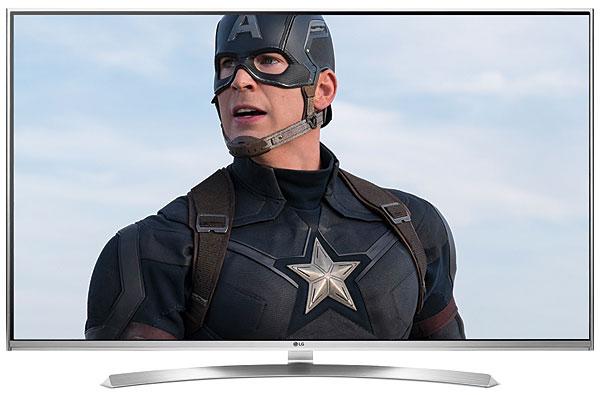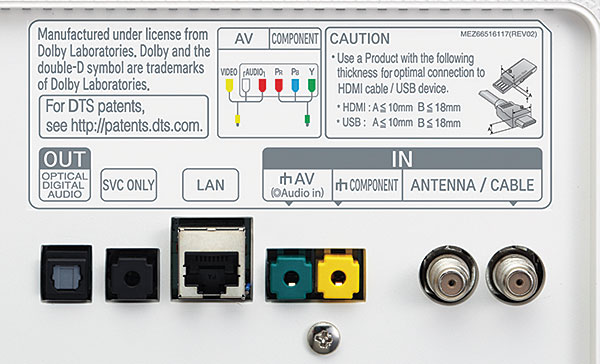LG 65UH8500 LCD Ultra HDTV Review

AT A GLANCE
Plus
HDR10 plus Dolby Vision HDR
Great color
Wide viewing window
Minus
Middling black levels
Backlight artifacts
THE VERDICT
LG’s midpriced 65UH8500 delivers good image quality with a super-wide viewing window, and it’s one of the few sets around that plays both predominant types of HDR content.
A year ago, I tested the LG 65UF9500, an LCD Ultra HDTV that retailed for $2,999, and I criticized it for offering no future-readiness for soon-to-emerge high dynamic range (HDR) content. Since then, Ultra HD Blu-ray has come to market, bringing HDR along with it, and there’s a growing library of HDR movies available for streaming. To LG’s credit, their line of so-called Super UHD LCD TVs for this holiday season, including the midline 65-inch 65UH8500 tested here ($1,700), recognizes both predominant types of HDR—namely, HDR10 (used currently on Ultra HD Blu-rays) and Dolby Vision (still only available via web streams). LG is one of only two TV makers to support both formats on a single chassis (in both their LCD and OLED models), the other being Vizio, which updated their Dolby Vision sets for HDR10 in mid-2016. So how does this wellfeatured, attractively priced set perform? Let’s have a look.
Points for Style
Dropped on my TV cart, the 65UH8500 made a nice impression. A thin brushed-metal bezel runs around the entire flat panel, which itself has an integrated black border and rides above the bezel to give the set a kind of glass-on-metal look. The contoured brushed-stainless-steel base provides rock-solid table mounting and lifts the TV up just a little more than 3 inches to the bottom of the image.
Around back, you’ll see a thin but slightly convex rear panel, dressed in white. You’ll also find three HDMI connections, all full version 2.0a with HDCP 2.2 (one with ARC), as well as a trio of USB ports (one 3.0), the antenna input, and a shared legacy connection for a component or composite video source. The optical audio output can be toggled between PCM and bitstream, and I verified that it passes 5.1-channel Dolby Digital or DTS core streams from sources presented to its HDMI inputs for feeding an outboard sound system. Alternatively, the TV has a Harman/Kardon-designed sound system; it played loud without distortion in my modest studio space and had no trouble rendering discernible dialogue, but it was nothing special.
As with their other LCDs, LG chose to use an IPS (in-plane switching) panel that boasts an extremely wide viewing angle; only the company’s OLED displays (and the industry’s old plasmas) can do better. Moving a mere 15 degrees off center from most LCDs results in noticeable loss of contrast, but the 65UH8500 showed no off-axis image shift from my seating distance 9 feet away, or even at extreme angles as close as 4 feet from the screen. As we’ve often noted, however, IPS panels sacrifice some black level performance compared with other common types, which was manifest here as well. Beyond this, the 10-bit panel features wide color gamut that achieves 90 percent of the DCI/P3 color space targeted for enhanced UHD content. LG verified that their 10-bit processing is maintained from input to screen. The company’s “Quantum Display” technology is on board, but that doesn’t refer to an advanced quantum-dot backlight, as is used in some other sets (notably Samsung’s); it only describes a collection of other image enhancements to improve contrast and color. The backlight here is of the local-dimming, edge-lit LED variety.


The set’s smart TV interface is LG’s own webOS 3.0, which offers a scrollable string of tiles on the bottom of the screen to access commonly used apps and settings. Combined with the floating cursor on LG’s Magic Remote, it makes for straightforward access to online content and source components. The usual suspects—Netflix, Amazon, Vudu, YouTube—were preloaded. Many others were available behind the LG Content Store tile, which offered suggested programming and apps but was also searchable.
A new feature called Channel Plus (turned on from the menu) adds streamed internet programming to the channel guide. Once activated, it added 50 web-based “channels” to the 68 digital broadcast channels my outdoor off-air antenna had already collected, most with rotating video clips from known news organizations and magazines. If you don’t like some of them, you can deselect these from your guide. LG also has a TV Plus app (for iOS and Android) that allows you to throw content and view apps from your smartphone.
 I’ve gotten used to the Magic Remote after using it on a few LG sets. Cursor drift remains an issue, though one easily corrected by pointing the remote beyond any edge of the screen until its apex aligns with the cursor. I like the button layout on this latest version, which puts the Home key (for calling up webOS), and the input select and Settings buttons, nearby the centrally positioned nav pad/clickwheel. A unified Search button activates the remote’s microphone for voice search. Speaking “the Kennedy assassination” into the remote yielded four movies or documentaries at various web streaming services, including JFK, Bobby, In the Line of Fire, and a William F. Buckley discussion about the Warren Commission report, plus a bunch of YouTube clips. A tile on the results screen took me straight to search results from the integrated web browser, where I could access Wikipedia and other links. Meanwhile, a neat “Live Zoom” button on the remote allows you to define a small section of the screen and zoom up as much as 300 percent; you can freeze the area or watch live action in that window. Another button activates the 3D mode: Yes, this is among the shrinking number of new sets that plays Blu-ray 3D discs. LG supplies two pair of passive glasses.
I’ve gotten used to the Magic Remote after using it on a few LG sets. Cursor drift remains an issue, though one easily corrected by pointing the remote beyond any edge of the screen until its apex aligns with the cursor. I like the button layout on this latest version, which puts the Home key (for calling up webOS), and the input select and Settings buttons, nearby the centrally positioned nav pad/clickwheel. A unified Search button activates the remote’s microphone for voice search. Speaking “the Kennedy assassination” into the remote yielded four movies or documentaries at various web streaming services, including JFK, Bobby, In the Line of Fire, and a William F. Buckley discussion about the Warren Commission report, plus a bunch of YouTube clips. A tile on the results screen took me straight to search results from the integrated web browser, where I could access Wikipedia and other links. Meanwhile, a neat “Live Zoom” button on the remote allows you to define a small section of the screen and zoom up as much as 300 percent; you can freeze the area or watch live action in that window. Another button activates the 3D mode: Yes, this is among the shrinking number of new sets that plays Blu-ray 3D discs. LG supplies two pair of passive glasses.
Geek Talk
The video menu offers 10 different image presets, including ISF Expert modes (Dark Room and Bright Room). There’s also an HDR Effect mode (with Low, Medium, and High options) that attempts to make standard dynamic range (SDR) content look more like HDR. Additionally, hidden presets kick in when the TV sees HDR signals. From the ISF Dark Room mode, the appearance of HDR10 triggers an HDR Bright mode, as well as options for HDR Vivid and HDR Standard. Dolby Vision triggers a dedicated Dolby Vision Movie Bright mode.
For my Rec. 709/SDR calibration, the ISF modes and Cinema modes presented the best baseline readings; all offer both 2-point and 20-point white balance controls for grayscale adjustments and a full CMS for color points. I settled on ISF Dark Room, which required only some modest tweaks in the 2-point white balance to ensure that red, green, and blue tracked evenly across the brightness range. But the set had some unusual issues with grayscale luminance, which, in reference to target values, went gradually up and then down in an arc (peaking at mid-brightness), returning to the correct level at 100 percent brightness. I spent a lot of time tweaking this with the 20-point controls but didn’t like the choppier end result, so I just restored those controls and let the luminance curve lie where it may. I also selected a classic 2.2 gamma curve. The LG defaults in the ISF modes to BT.1886, which is closer to a 2.4 gamma and considered the industry standard for new content. But the set did a noticeably better job maintaining the targets for 2.2, and most legacy content we watch was mastered in 2.2 anyway. Meanwhile, the color points included an understated blue primary that measured a larger error than we’d like. Fixing it with the CMS made the measurements look better but resulted in exaggerated noise in some blue objects. I ended up making only a couple of minor tweaks to the default color settings, but as you’ll see, I had no complaints about the end result.



























































